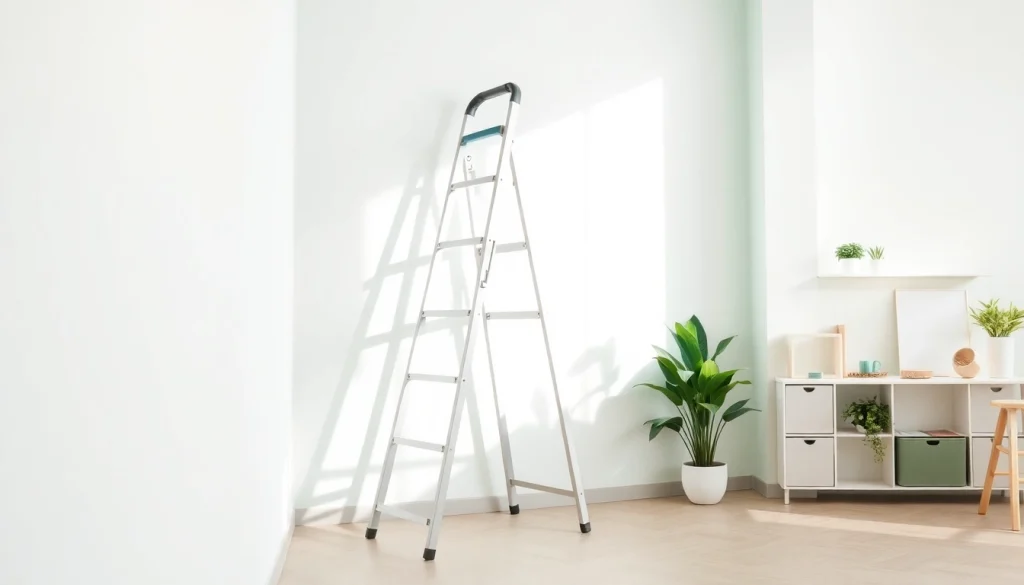
Understanding the Step Ladder: What You Need to Know
Step ladders are essential tools for tasks that require reaching heights that exceed our natural reach. From hanging curtains to accessing high shelves, having the right step ladder can make all the difference in ensuring safety and efficiency. In this article, we’ll explore the different types of step ladders, key features to consider, and popular applications to help you make informed decisions.
1. Types of Step Ladders and Their Uses
Step ladders come in various types, each designed for specific tasks and environments. Understanding these types allows you to choose the best ladder for your needs:
- A-Frame Ladders: These are the most commonly used step ladders with two angled sides that create a stable base. They’re versatile and great for household tasks.
- Platform Ladders: Offering a wider top platform, these ladders provide more stability when working at height. They are ideal for jobs requiring longer periods of standing, such as painting.
- Multi-Purpose Ladders: These can be configured into various shapes, including A-frame, extension, and ladder configurations. Their flexibility makes them suitable for multiple tasks.
- Folding Step Stools: Lightweight and portable, folding step stools are perfect for quick tasks where a full ladder is not needed.
- Wall Ladders: Specifically designed to be placed against walls for maintenance, these ladders often feature an extended reach and stability for those heights that standard step ladders cannot achieve.
2. Key Features to Look for in a Step Ladder
When selecting a step ladder, look for features that enhance safety, durability, and convenience:
- Weight Capacity: Ensure the ladder can support not only your weight but also any tools or materials you’ll be carrying.
- Material: Common materials include aluminum, fiberglass, and wood. Aluminum is lightweight and rust-resistant, while fiberglass is non-conductive, making it safer for electrical work.
- Height: Choose a ladder that allows you to reach your target height comfortably without overstretching.
- Safety Features: Look for ladders with slip-resistant feet, locking mechanisms, and additional stabilizers that provide added security while you work.
- Portability: If you need to move the ladder frequently, consider its weight and whether it can be easily folded or transported.
3. Common Applications for Step Ladders
Step ladders are versatile tools that find use in various settings:
- Home Improvement: Perfect for tasks like painting, changing light bulbs, or reaching high shelves.
- Office Use: Great for organizing supplies in cabinets, hanging decorations, or performing maintenance tasks.
- Gardening: Useful for pruning trees or accessing high planter boxes.
- Retail and Warehousing: Essential for stocking shelves and retrieving items from high locations.
Choosing the Right Step Ladder for Your Needs
1. Assessing Height and Weight Requirements
Choosing the proper height for your step ladder is crucial. Measure the highest point you need to reach and select a ladder with a few extra feet for safety. Additionally, consider the weight rating of the ladder, including your weight and the weight of any tools or materials you may be carrying. Most ladders come with a classification system that indicates their weight capacity, typically ranging from 200 pounds (Type III) to over 300 pounds (Type IA).
2. Materials and Their Benefits in Step Ladders
Different materials offer unique advantages:
- Aluminum: Lightweight, rust-proof, and resistant to weather. Ideal for both indoor and outdoor use.
- Fiberglass: Strong and non-conductive, making it a safe choice for electrical work.
- Wood: Classic and sturdy, but can be heavier and requires maintenance to prevent rot or splintering.
3. Recommendations for Everyday Use
For everyday household tasks, a three to four-step A-frame ladder is usually sufficient. If you regularly perform tasks requiring more reach, consider investing in a multi-purpose ladder, which offers flexibility for a variety of jobs. For those who tend to prioritize convenience, lightweight folding stools can be handy for quick access to high spaces.
Safety Guidelines When Using a Step Ladder
1. Understanding the 1-in-4 Rule
The 1-in-4 rule is a fundamental safety guideline for ladder stability. This rule states that for every four feet of ladder height, the base should stand one foot away from the wall or vertical surface. This ensures the ladder is at a safe angle, reducing the risk of falling.
2. Essential Safety Features to Look For
To ensure safe usage of your step ladder, look for the following features:
- Non-slip feet: These prevent the ladder from sliding during use.
- Sturdy construction: Ensure the ladder is made from durable materials that can withstand regular use.
- Locking mechanisms: Always check that the ladder locks securely in place when extended.
3. Common Safety Mistakes to Avoid
Be mindful of these common mistakes to enhance your safety:
- Overreaching: Avoid stretching beyond your reach as it can cause your balance to shift, leading to falls.
- Improper positioning: Always ensure the ladder is on solid ground and positioned correctly.
- Ignoring maintenance: Regularly inspect your ladder for wear and tear to prevent accidents caused by faulty equipment.
Step Ladder Maintenance: Keeping It in Top Shape
1. Regular Inspections and When to Replace
Make it a practice to inspect your ladder regularly. Look for signs of wear such as dents, bent rungs, or cracks. If any major issues are found, it may be more prudent to invest in a new ladder rather than risk your safety.
2. Cleaning and Storing Your Step Ladder Properly
To prolong the life of your step ladder, clean it after use to remove dirt and grime. Store it in a dry place away from extreme temperatures to prevent warping or rust, particularly in metal ladders. Always fold it correctly and avoid leaving it upright in a way that could lead to tipping or falling.
3. Repair Tips for Minor Damages
For minor issues, such as loose screws or minor scratches, you can often make simple repairs yourself. Tightening loose screws and applying protective coatings can help maintain the integrity of your ladder. However, always refer to manufacturer guidelines for repairs to ensure you make safe adjustments.
Maximizing the Efficiency of Your Step Ladder
1. Creative Uses for Your Step Ladder
Besides standard uses for maintenance tasks, there are creative applications for your step ladder:
- Decoration: Use a ladder as a unique display for plants or photos.
- Storage: Convert it into shelving for books or crafts in your home.
- Outdoor projects: Utilize ladders to reach tall garden areas or create outdoor art displays.
2. Enhancing Productivity with Right Techniques
To make the most of your step ladder, prepare your workspace. Organize your tools before ascending the ladder, and minimize trips up and down. This practice not only saves time but enhances safety as well.
3. Organizing Your Space with a Step Ladder in Mind
Incorporate your step ladder into your home organization strategy. Consider areas where items are frequently out of reach and maintain those spaces using designated shelving accessible via your ladder. This can help reduce clutter and ensure that your storage solutions are both effective and safe.






